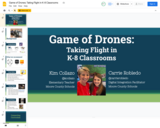
An engaging lesson using Dash robot to help students identify and describe different attributes of landforms.
- Subject:
- Applied Science
- Computer Science
- Social Studies
- Material Type:
- Activity/Lab
- Date Added:
- 03/17/2023

An engaging lesson using Dash robot to help students identify and describe different attributes of landforms.

This is a REMIX of Shelton and Robledo's "Solar Oven Engineering". An excel document has been added to assist in data collection, record keeping, and graph generation.Students can work individually or in groups of 3 or 4 to create a solar oven out of a pizza box. Students are trying to figure out the best way to make a solar oven in order to melt the chocolate and marshmallow in the S’more. Students will be given a group of objects and tell them the basis of how to create a solar oven. The oven will need to be placed in direct sunlight for most of the day. This experiment works best on a very hot, sunny day.

Students can work individually or in groups of 3 or 4 to create a solar oven out of a pizza box. Students are trying to figure out the best way to make a solar oven in order to melt the chocolate and marshmallow in the S’more. Students will be given a group of objects and tell them the basis of how to create a solar oven. The oven will need to be placed in direct sunlight for most of the day. This experiment works best on a very hot, sunny day.

In this activity, students will extend their unit on printmaking by designing and creating a stamp using Tinkercad. With class set up and planning done ahead of the lesson, this can be completed in one class period.

Investigate engineering and create a working prototype using the design thinking process.

These are the slides that Cohort 1 folks utilized to generate ideas and make connections on 4/19/22.

In this problem-based learning module, students will use their knowledge of the ancient Roman Empire and will work to analyze critical theories historians agree contributed to the fall of Rome. Students will then work to compare the problems faced by the Romans with problems citizens of the United States still largely face today. Through this investigation, students should recognize how modern technology, government agencies, laws and resources help to solve societal problems that could have once destroyed an empire. With this new understanding, students should work to present a solution to a major problem that plagued the Roman Empire during the years leading up to its collapse.

Design and build extensions onto the Driving Base and program it to complete two tasks. Students will learn and practice engineering and manufacturing techniques, cooperation and teamwork skills as they build and code an Autonomous Mobile Robot.

This nearpod goes through the steps of how to create a Digital Breakout for differentiation and personalized learning in the classroom.

Students construct a bridge that will get Cupid to his destination and withstand all of his Valentines. They will build a bridge with only candy hearts and toothpicks.

Each group will build a different building 2-level wing of the team's school in one day but can only use the materials provided to the team. Each wing must include several classrooms for drones to survey and land.

Students will have to decide and plan which items they want Dash to go after during a game demonstrating the effects of supply, demand, and scarcity.

Presentation provides various ways teachers can incorporate drones into the 4 major disciplines of the curriculum.

In this lesson students work in collaborative groups to collect, represent, and interpret numerical data that they generate by using Sphero robots to knock down bowling pins!

Students will engineer a house that can withstand the force of a hurricane. Students will think about wind forces and the structures of houses to create their house using certain materials.

Students will use bots (Sphero Indi or Beebots) to make a shape demonstrating not only their understanding of the attributes of shapes but of the technology required to apply it.

Make a map that leads to a new continent. Students will code a Sphero to travel the path of the map.

To create a map that leads to a new “imaginary” continent. Then students will code spheros to travel a route they created.
Driving Question: Reading The Last Mapmaker, by Christina Soontornvat students will learn about what goes into making a map of a new territory. Student will take that new knowledge about the importance of map making vs. blindly following GPS
How did people get from one place to another before GPS and how do people create maps

3-6 Teacher directions to help educators understand and use the Mooresville Online Academy Grant modules with students.

Explore what coding is and create your own game without using a computer!